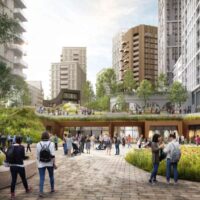Our SDGs story: Q&A with Nitesh Magdani, Group Director Sustainability, Royal BAM Group
March’s Futurebuild conference will be focusing on taking action to achieve the UN Sustainable Development Goals (SDGs). Bioregional Head of Comms and Policy Julia Hawkins spoke to Nitesh Magdani, Group Director Sustainability, Royal BAM Group about how its using the Goals.
Why do you think it's important that construction companies help to implement the Sustainable Development Goals?
There's no single metric that companies use to assess progress against all sustainability things - environmental, economic, social. A lot of the focus that we see in the construction industry is around the environmental aspects like climate change not so much on economic or social issues. The SDGs give us that point of reference for global issues that all companies need to deal with. They highlight certain agendas that may not be construction specific, but everyone needs to get onto them.
How is BAM using the SDGs in its own sustainability work?
What BAM has done so far is to align our strategy as it currently stands; we've not changed it because of the SDGs… Let's say seven SDGs align with the work that we're doing already.
Going forward, we want to be more considered in how we're measuring our progress against those SDGs. I don't think anyone is there yet. Because of this we've signed up to be on the Members Advisory Committee of the One Planet Network. It's a UNEP Advisory Committee helping to develop an industry-wide action plan for our industry.
I'm also the chair of the sustainability working group of Encord, a European network of contractors collaborating on R&D work with approx 20 major companies involved. Being part of the One Planet Network helps facilitate our own progress against the SDGs, but it also helps me take learning back to other construction companies through Encord.
Do you see industry-wide collaboration as an important part of progress towards the SDGs?
I don’t think that one company will make any difference, especially when you have supply chains so intertwined as ours are. If you purchase a lift, no-one's really asked questions about where the components come from, who's manufacturing it, and what the labour conditions are. This is not the sort of issue where we can set our own targets and methodology; it's not like a science-based target where you've got the ultimate ambition to limit temperature rise to 1.5 degrees (currently 2 degrees) by 2050 by doing x, y, and z. As an organisation, we are committed to play our part in this.
We need to break the SDGs down for the construction and built environment sector. Rather than different companies just going off and interpreting the SDGs in our own way, we need to come up with a framework, a methodology, an action plan – it’s not currently there but I think the industry will get behind it.
We're hoping the One Planet Network and our involvement will help to frame that concept. We have a strategy day in a couple of weeks in Paris to try and make it more tangible.
What would be your top tip to other construction or built environment companies that might be struggling to get to grips with the SDGs?
Firstly, look at the resources, look at the commitments, the SDGs themselves and try to understand them. It’s key that you do your own analysis on that. Also look at the United Nations Environment Plan (UNEP) resources.
Through the One Planet Network, we are reporting on our progress. We've contributed two project examples where we've done circular buildings and briefly explained how they contribute to SDG 12 as well as an initiative to start up a digital marketplace for materials exchange.
Through these two projects and others, we realised that finding reused or reusable construction materials is really difficult. There's no materials platform that helps you trade these materials, so with the help of IBM we set up a concept for a materials trading platform. Now we're looking at scaling it up and getting funding to make it industry wide.
Do you think your clients are becoming more engaged with the SDGs?
Where we've delivered circular buildings, clients are really engaged by the fact that the asset we're building for them will potentially be worth more if we construct it so that it can be reused or repurposed. Typically, the material value of a conventional building at demolition phase stage is less than 10% of its original value. But, when working with ABN AMRO in Amsterdam, one of the largest banks in the Netherlands, and others, generally we're achieving residual values of certain materials over 50% - a huge difference.
The ABN AMRO building was their test case, it was them saying: “We’re starting an investment fund in circularity, but we should understand it as well.” The building we've created for them helps them to get to grips with it and showcase what circularity is.
In the UK we participate in a lot of roundtable discussions on circularity in the Built Environment. The UKGBC is now starting to do something around this and we’re one of the knowledge partners alongside ARUP to help progress these issues.
We've also advised the Greater London Authority and the HS2 high speed rail project among other clients. A couple years ago together with Arup, Frener & Reifer and The Built Environment Trust, we designed and built a circular pavilion outside the Building Centre in London. We've also recently completed a circular retrofit to a lighting scheme up in Cheshire, managed by our own BAM PPP.
But as yet there are no real demonstration projects at scale in the UK. No client has come forward to us yet and said: ‘We are making the commitment to either work with circularity or the SDGs as a key driver for our project.’
I think the SDGs will help unite us, small and large organisations, to keep abreast of those global issues. I hope that they'll take off and that we'll be able to be slightly more tangible around: ‘This is what we want to achieve, and this is how we are coming together to create a fairer, ethical and cleaner society.
How optimistic do you feel about the potential for the construction industry to change?
Whether it's retail, fashion, automotive or the built environment industry, we all have our own issues we need to deal with in our own supply chain. Historically we've been fairly detached from our supply chain. It's an area that we've begun to pay more notice to over the last five (to ten) years but there's still a long way to go.
I think the SDGs will help unite us, small and large organisations, to keep abreast of those global issues. I hope that they'll take off and that we'll be able to be slightly more tangible around: ‘This is what we want to achieve, and this is how we are coming together to create a fairer, ethical and cleaner society.’ We're not quite there yet.
If you're coming to Futurebuild 2019, join Bioregional's workshop with practical advice on how to incorporate the SDGs in your business or development project: Learn how to use the SDGs in your work - 4.30-5.40pm, Wednesday 5 March.
Check out all Bioregional's sessions at Futurebuild 2019.
Build a better future: the built environment and the Sustainable Development Goals
Built environment companies are struggling to get to grips with the Sustainable Development Goals. So we've created an easy-to-digest guide with practical advice on how to get started. Let's build a better future together
Download PDF







